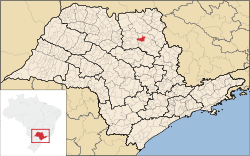Sertãozinho
| Sertãozinho | |||
|---|---|---|---|
| Municipality | |||
 |
|||
|
|||
 Location in São Paulo state |
|||
| Location in Brazil | |||
| Coordinates: 21°8′17″S 47°59′26″W / 21.13806°S 47.99056°WCoordinates: 21°8′17″S 47°59′26″W / 21.13806°S 47.99056°W | |||
| Country |
|
||
| Region | Southeast Region | ||
| State | São Paulo | ||
| Area | |||
| • Total | 403 km2 (156 sq mi) | ||
| Elevation | 579 m (1,900 ft) | ||
| Population (2015) | |||
| • Total | 120,152 | ||
| • Density | 300/km2 (770/sq mi) | ||
| Time zone | BRT/BRST (UTC-3/-2) | ||
| Postal code | 16000-000 | ||
| Website | www |
||
Sertãozinho is a Brazilian municipality in the state of São Paulo. The population in 2005 was about 120,152 making it one of the most populous cities in Brazil. Its area is 403 km². The municipality consists of Sertãozinho city and two districts: Cruz das Posses and Vila Garcia. Sertãozinho is 325 km from São Paulo and 702 km from Brasília.
In 1877, a settlement at Sertãozinho was founded on 148 acres (0.60 km2) of land belonging to local farming estates. The land holders involved included Antonio Pedroso Malachi, Antonio Jose Rodrigues, Manoel Jacinto Bridge and Father Chico of Africa. Malachi, whose estate was called "Vila Nossa Senhora Aparecida", donated about 12 acres (49,000 m2) of land which was divided amongst tenant farmers. He built a chapel dedicated to the Blessed Virgin Mary (located at 21 de Abril Plaza).
On 10 March 1885, under law 31, the village was made a district of peace. On 5 December 1896, the village was made a town and named Ali Sertãozinho by law 463. This was ratified on 21 April 1897. On 26 October 1906, under law 1018, the district was founded and ratified on 12 December 1906. The name of the municipality has changed over time, including, Capela de Sertãozinho, Engenho de Nossa Senhora Aparecida do Sertaozinho, Aparecida de Sertãozinho, and its current name, Sertãozinho. The first municipal magistrate was Renato Silveira da Motta.
For many years, the main industry of the municipality was coffee production. However, the coffee fields became exhausted and the land was sold to colonos (former colonists) and investors who planted cotton. By 1920, Sertaozinho was one of the top ten cotton producing areas in Brazil.
In 1928, although union membership was illegal in Brazil, communist entities organised dissident workers on the larger coffee plantations in Sertãozinho.
...
Wikipedia



